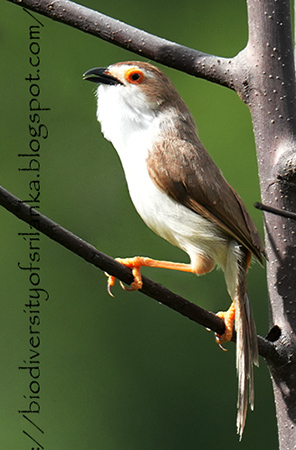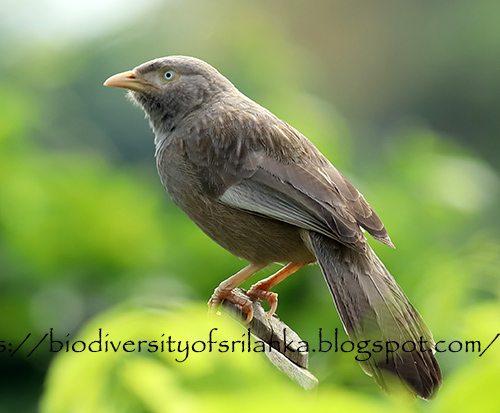English Post >>
Pages
- Home
- Flora of Sri Lanka
- Dragonflies & Damselflies of Sri Lanka
- Butterflies of Sri Lanka
- Freshwater Fishes of of Sri Lanka
- Amphibians of Sri Lanka
- Snakes of Sri Lanka
- Tetrapod Reptiles of Sri Lanka
- Mammals of Sri Lanka
- Resident Birds of Sri Lanka
- Migrant Birds of Sri Lanka
- Vagrant Birds of Sri Lanka
- Status Uncertain or Doubtful Birds of Sri Lanka
Showing posts with label Babblers. Show all posts
Showing posts with label Babblers. Show all posts
Thursday, August 15, 2024
නෙත් කහ තණ දෙමළිච්චා/ඇස් කහ දෙමළිච්චා (Chrysomma sinense)
පහතරට ප්රදේශ වල සිට කඳුකරයේ මධ්යම උස් මට්ටම් දක්වා එතරම් සුලභ නොවන ලෙස ස්ථානීය වශයෙන් තෘණ භූමි සහ ලඳු කැලෑ වල හමුවන දේශීය පක්ෂියෙකි. පහත රට වියලි කලාපයේ තරමක් සුලභ නමුත් තෙත් කලාපයේ සහ කඳුකරයේ දුර්ලභය. ජෝඩු වශයෙන් හෝ කුඩා රංචු ලෙසින් බොහෝවිට ඝනව වැවුණු පඬුරු අතරින් ගමන් කරමින් ප්රධාන වශයෙන් කෘමීන් ගොදුරු කරගනිමින් දිවි ගෙවයි. නමුත් සැන්දෑ කාලයේදී විවෘත ස්ථානයක පිහිටි ගසක අතු මත ලගිමින් සිය ඝෝෂාකාරී නාදය නගමින් කෑගසන පක්ෂීන් නිරීක්ෂණය කල හැක. පෙබරවාරි සිට මැයි දක්වා කාලයේ දිගු තෘණ පත්ර මකුළු දැල් වලින් එක්කර මාන වර්ගයේ තෘණ ගස් කිහිපයක කඳවල් වලට සවි කර තනන කෝප්පයක හැඩැති ගැඹුරු කූඩුවක බිත්තර තුනක් හෝ හතරක් දමා අභිජනනයේ යෙදේ.
Thursday, April 18, 2024
කුස කහ ලඳු-දෙමළිච්චා/ගෙල සුදු දෙමළිච්චා (Dumetia hyperythra)
පහත රට තැනිතලා බිම් වල සිට කඳුකරයේ මීටර් 1500 ක් පමණ වන උස් මට්ටම් දක්වා හෝ ඇතැම් ප්රදේශ වල ඊටත් වඩා උස් කඳුකර ප්රදේශ දක්වාත් එතරම් සුලභ නොවන ලෙසින් ස්ථානීයව වනාන්තර, ලඳු කැලෑ, තෘණභූමි සහ එවන් පරිසර පද්ධති වලට ආසන්න හොඳින් ගහ කොළ සහිත ගෙවතු වලත්, තේ වතු වලත් දැකිය හැකි දේශීය පක්ෂියෙකි. වියලි කලාපයේ වඩාත් සුලභ වන අතර තෙත් කලාපීය වනාන්තර තුල හමු නොවේ. කුඩා රංචු වශයෙන් තෝරාගත් විශාල ප්රදේශයක් පුරා තෘණ භූමි, ලඳු කැලෑ හෝ වනාන්තර යටිවියනේ පිහිටි පඳුරු අතර නිතර එකිනෙකා සමග නාද කරමින් සබදතාවය පවත්වා ගනිමින් සැඟවී ගමන් කරමින් ප්රධාන වශයෙන් කෘමීන් සහ කුඩා ගෙඩි වර්ග ආහාරයට ගනිමින් දිවි ගෙවයි. මාර්තු සිට මැයි දක්වා සහ බොහෝවිට නැවත අගෝස්තු සිට සැප්තැම්බර් දක්වා වියලි තණකොල, කෝටු කැබලි සහ කෙඳි ආදිය උපයෝගි කරගනිමින් පැත්තකින් ඇතුළු වීමට හැකි වන ලෙසට බෝලයක හැඩයට තනන කූඩුවක බිත්තර තුනක් හෝ හතරක් දමා අභිජනනය සිදුකරයි. කූඩුව බොහෝවිට පඳුරක හෝ මානා ගාලක පොළොවට ආසන්නව ඉදිකරයි
English Post >>
English Post >>
Saturday, November 25, 2023
Yellow-eyed Babbler/නෙත් කහ තණ දෙමළිච්චා/ඇස් කහ දෙමළිච්චා [/Neth Kaha Tana Demalichcha/As Kaha Demalichcha] (Chrysomma sinense)
Uncommon and local breeding resident of grasslands and scrublands from lowlands to mid hills. Much common in the dry lowlands and rare in the wet zone and hills. It lives as pairs or as small flocks, skulking mostly in dense shrubbery, feeding mainly on insects. But towards the evening they often perch on twigs in a open place and utter its loud call. Main breeding season lasts from February to May. The nest is a deep cup made out of grass-blades bound with cobwebs, which fastened to several stems of long Mana type grasses, where it lays three or four eggs.
සිංහලෙන් කියවන්න >>
Tuesday, July 4, 2023
රෙදි දියන්/හිස දුඹුරු දෙමළිච්චා/ශ්රි ලංකා බොරග පිරී දෙමළිච්චා (Pellorneum fuscocapillus)
හිස දුඹුරු දෙමළිච්චා පහත රට ප්රදේශ වල සිට කඳුකරයේ මධ්යම උස් මට්ටම් දක්වා වනාන්තර වල ස්ථානිය වශයෙන් තරමක් දුර්ලභ ලෙස හමුවන මෙරටට ආවේනික පක්ෂියෙකි. වනාන්තර යටි වියනේ වැඩි වශයෙන් කාලය ගත කරන මෙම පක්ෂියා බොහෝවිට ජෝඩු වශයෙන් හෝ කුඩා රංචු ලෙසින් කොළ රොඩු අතර කෘමීන් සොයමින් හැසිරේ. හිස දුඹුරු දෙමළිච්චාගේ නොනැවතී ඇසෙන නාදය රෙදි දියන් ලෙසින් ඇසෙන හෙයින් ගැමියන් අතර රෙදි දියන් ලෙසින් හැඳින්වෙන මෙම පක්ෂියා වසරේ නොවැම්බර් සිට මාර්තු අතර කාලයේ හෝ නැවතත් සැප්තැම්බර් මාසයේ ඝන වනාන්තරයේ ගසක් හෝ පඳුරක් පාමුල වියලි කොළ වලින් අපිලිවෙලකට තැනූ ගෝලාකාර කූඩුවක බිත්තර දෙකක් දමා අභිජනනයේ යෙදේ.
English Post >>
Saturday, August 20, 2022
Tawny-bellied Babbler/White-throated Babbler/Rufous Bellied Babbler/කුස කහ ලඳු-දෙමළිච්චා/ගෙල සුදු දෙමළිච්චා (Dumetia hyperythra)
Tawny-bellied Babbler is a local and rather uncommon breeding resident inhabiting forests, scrublands, grasslands, adjoining well wooded home gardens and tea plantations from lowlands to about 1500 m elevations in the mid hills or even higher in some areas. Much common in the dry zone and avoids interior of the wet zone forests. It lives as small flocks, maintaining a large territory and skulking among bushes in grasslands/scrublands or undergrowth of the forest, moving one after other with squeaks of alarms and chattering or churring notes. It feeds mainly on insects and berries. The breeding season lasts from March to May and probably again from August to September. The nest is a ball of dry grasses, twigs and fibers with an entrance hole on the side, sets usually near ground in a bush, tussock of a Mana grass or the like, where it lays 3 or 4 eggs.
සිංහලෙන් කියවන්න >>
Friday, April 8, 2022
පුංචි දෙමලිච්චා/වතඳුරු පඳුරු දෙමලිච්චා/හිස කළු දෙමලිච්චා (Rhopocichla atriceps)
සියළුම දේශගුණික කලාපවල පාහේ වනාන්තර වල යටි රෝපනයේ කෘමින් ගොදුරු කරගනිමින් කුඩා රංචු වශයෙන් හැසිරෙන දේශීය පක්ෂියෙකි. ප්රධාන වශයෙන් පෙබරවාරි සිට මැයි දක්වාත් , ඇතැම්විට නැවතත් ඔක්තෝබර් සිට නොවැම්බර් දක්වාත් අභිජනනයේ යෙදෙන මෙම කුඩා දෙමලිච්චා වියලි කොල කැබලි වලින් ගස් දෙබලක් මත විශාල විවරයක් සහිත ගෝලාකාර කූඩුවක් තනා එහි බිත්තර දෙකක් දමා පැටවුන් බිහි කරයි.
Monday, February 14, 2022
දෙමළිච්චා (Turdoides affinis taprobanus)
ගෙවතු, වගා බිම් සහ මිනිස් වාසයන්ට ආසන්න වනගත ප්රදේශ වලද ඉතාමත් සුලභ දේශීය පක්ෂියෙකි. නමුත් ඝන වනාන්තර සහ කඳුකරයේ දුර්ලභය. බොහෝවිට හතට වඩා වැඩි කුරුල්ලන්ගේ රංචු වශයෙන් හමුවේ. එම හේතුව නිසාම ඉංග්රීසි භාෂාවෙන් Seven Sisters ලෙස හඳුන්වයි. කෘමින් මෙන්ම ශාකමය ද්රව්යද ආහාරයට ගන්නා දෙමලිච්චා එවන් බොහෝ ආහාර පොළොව මතු පිටින් ලබාගනී. මාර්තු සිට මැයි දක්වා සහ බොහෝවිට නැවතත් අගෝස්තු සිට නොවැම්බර් දක්වා කාලයේ අභිජනනයේ යෙදේ. ගැඹුරු කෝප්පයක හැඩයෙන් යුත් කූඩුව පඳුරක මනාව සැඟවෙන පරිදි තනා එහි බිත්තර තුනේ සිට පහ අතර ප්රමාණයක් දමයි.
English Post >>
Wednesday, April 8, 2020
රතු දෙමලිච්චා (Turdoides rufescens)
මෙරටට ආවේනික පහත රට තෙත් කලාපයේ සහ ආසන්න කඳුකර ප්රදේශ වල වනාන්තර වල හමුවන පක්ෂියෙකි. පක්ෂීන් 7 -10 හෝ ඊට වැඩි රංචු වශයෙන් ජීවත් වන රතු දෙමලිච්චන් ආහාර සොයා එකම මගක ගමන් කරන කුරුළු විශේෂ ගණනාවකින් සමන්විත කුරුළු නඩ වලද සාමාජිකයෙකි. වනාන්තරයේ යටි වියනේ සහ ගස් වල පහත අතු මතින් ගමන් කරමින් කෘමීන් සහ කුඩා ගෙඩි වර්ග ආහාරයට ගන්නා රතු දෙමලිච්චන් වසරේ ජනවාරි සිට මැයි දක්වා කාලයේ අභිජනනයේ නියැලේ. තද කොළ පැහැති බිත්තර සහ කූඩුව පොදු දෙමලිච්චාගේ කූඩුවට සහ බිත්තර වලට බෙහෙවින් සමාන අතර එය පඳුරු අතර මනාව සැඟවුණ ස්ථානයක ඉදිකරයි.
English Post >>
English Post >>
Monday, March 9, 2020
දෑකැති දෙමලිච්චා/ශ්රී ලංකා දෑ දෙමලිච්චා[Daekaeti Demalichcha/Sri Lanka Dae Demalichcha]/Sri Lanka Scimitar-babbler (Pomatorhinus melanurus)
Sri Lanka Scimitar-babble is an uncommon endemic bird inhabiting forests and well wooded areas as well as the adjoining scrubs and home gardens throughout the country though rather rare in the dry lowlands. It lives as pairs or as family parties and often associates with feeding flocks consisting of other birds and travel through the forest in search of its insect prey in bark crevices, moss covered tree trunks, dead leaves etc. It breeds from March to May and again at the end of the year. The nest is a closed globular with a side entrance made out of grass blades, dead leaves, twigs and fibers, placed among dense herbage, ferns, etc. close to the ground or sometimes in a tree cavity or a deep fork. It lays two or three white eggs in it.
Two races occurs. Race melanurus peculiar to the low country wet zone and south-western hills while race horsfieldii found in dry lowlands and hills.
Two races occurs. Race melanurus peculiar to the low country wet zone and south-western hills while race horsfieldii found in dry lowlands and hills.
Tuesday, January 15, 2013
රතු දෙමලිච්චා[Rathu Demalichcha]/Orange-billed babbler ( Turdoides rufescens)
Orange-billed babbler is a locally common
endemic bird found in wet lowland and adjoining hill country forest areas. It
lives as flocks of 7-10 individuals or more and also a regular species in ‘mixed
feeding flocks’. It feeds on insects and also jungle berries, fluttering from
tree to tree in lower foliage of trees and understorey of the forest. Little
information available on its nesting habitats and breeding season is said to be
from January to May and grass cup nest well hidden among creepers or bush and deep
greenish eggs resembles Orange-billed babbler’s nest and eggs and difficult to distinguished.
සිංහලෙන් කියවන්න >>
Thursday, August 2, 2012
Brown-capped Babbler/රෙදි දියන්/හිස දුඹුරු දෙමළිච්චා/ශ්රි ලංකා බොරග පිරී දෙමළිච්චා (Pellorneum fuscocapillus)
An uncommon and endemic bird distributed locally from lowlands to mid hill forests. It is a bird of undergrowth and spends its time mostly on seeking insects among leaf litter usually as pairs or as small flocks. Brown-capped Babbler breeds during November to March and again in September. The nest is an untidy dome of dead leaves, set at base of a tree or shrub in deep forest. Two races can be identified in Sri Lanka
සිංහලෙන් කියවන්න >>
Wednesday, August 10, 2011
Dark-fronted Babbler (Rhopocichla atriceps)

Dark-fronted
Babbler is a bird of forest undergrowth of all zones. Generally found in as small
flocks feeding on insects among foliage. The main breeding season is from
February to May and perhaps again from October to November. The nest is a ball of dead leaves with wide
opening in one side, placed on a fork of tree.
සිංහලෙන් කියවන්න >>
Sunday, April 10, 2011
දෙමළිච්චා [Demalichcha]/Yellow-billed babbler/Seven sisters(Turdoides affinis taprobanus)
Very common breeding resident of Gardens, cultivations and forested
areas close to anthropogenic habitats but rare in the higher hills and thick forests. Usually found in flocks of several birds often more than seven, hence
the name ‘seven sisters’. It feeds on
both insects and vegetable stuffs and most of its food is taken on the ground.
Main breeding season is from March to May and perhaps again in August-November.
සිංහලෙන් කියවන්න >>
Subscribe to:
Comments (Atom)











